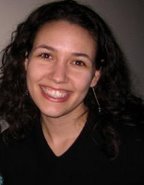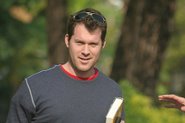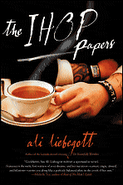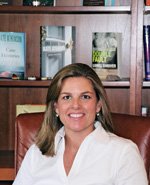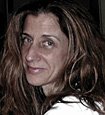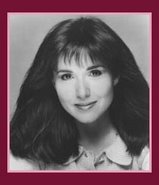









Rick Riordan is best known for his YA series Percy Jackson and the Olympians and also for his series of multi-award-winning adult mysteries featuring San Antonio P.I. Tres Navarre.
He was Born and raised in San Antonio, Texas on June 5, 1964. He knew from the time he was young that he wanted to grow up to be a teacher and a writer. His father was a ceramicist and his mother was a musician; both were teachers.
The first book he ever read was the Lord of the Rings' series. He began his writing in middle school. His favorite topic in middle school was Greek and Norse mythology; he also liked to read fantasy and science fiction books. His biggest inspiration was his 9th grade English teacher, Mrs. Seaholm, who often pushed him to write. His first job was at a middle school in New Braunfels, Texas.
He went to Alamo Heights High School and became interested in mystery novels. That’s where he got his inspiration to write adult mystery novels because they intrigued and fascinated him. He also was caught writing an underground newspaper that made fun of their school’s football team.
He went off to college at first North Texas State. He transferred to the University of Texas at Austin in 1986 where he graduated with a double -major in English and History.
After college, he became a teacher, and was quite happy with the idea of doing that the rest of his life. He was a teacher for 6 to 7 years at Presidio Hill School & Saint Mary’s Hall and also worked as a music director at Camp Capers for 3 years.
In 1997 he began publishing mystery novels “Tres Navarre” mystery series for adults. The series has won the top three national awards in the mystery genre – the Edgar, Anthony and the Shamus.
Tres Navarre is a Tex-Mex thriller featuring San Antonio PI. Jackson "Tres" Navarre, a complicated loner with an offbeat pedigree. Navarre is a tai chi master with a University of California English Ph.D. degree in medieval literature who turns to detective work when he is unable to find a teaching job!
His first novel in the Tres Navarre series is Big Red Tequila. The sequel, The Widower's Two-Step, won the coveted Edgar Award in 1999. THE LAST KING OF TEXAS; and THE DEVIL WENT DOWN TO AUSTIN. He is also the author of the acclaimed thriller COLD SPRINGS
Rick Riordan has presented workshops for such organizations as the International Reading Association, the California Association of Independent Schools, the National Council for Teachers of English, the Colonial Williamsburg Teacher Institute and the Texas Library Association.
Reluctantly, he left teaching a career he thoroughly enjoyed in order to write full-time. He still harbors hopes that someday he'll return to the classroom. Meanwhile, he makes frequent visits to schools and enjoys meeting young readers on his book tours. For a total of fifteen years, he taught history in public and private middle schools in the San Francisco Bay Area in California and also in San Antonio Texas. In 2002, Saint Mary’s Hall honored him with the school’s first Master Teacher Award. In 2003, he was inducted into the Texas Institute of Letters.
He wrote grown-up mystery novels for about seven years before he even started the Percy Jackson series for young readers. He began Percy Jackson: The Lightning Thief as a bedtime story that he invented for his son Haley -- who, at eight, had just been diagnosed with learning disabilities. Although Haley was having trouble in school, he loved the Greek myths and asked his dad to tell him some stories about the gods and heroes.
Motivated by his sons’ request, Mr. Riordan quickly came up with the character of Percy Jackson and told Haley all about Percy's quest to recover Zeus's lightning bolt in modern-day America. It took him about three nights to tell the whole story, and when he was done, Haley told his dad that he should write it out as a book. He chose to give the character of Percy certain attributes that hit close to home.
The Lightning Thief won the Red House Children's Book Award in June 2006.Percy Jackson and the Olympians is a terrific YA series that features a twelve-year-old trouble-prone boy with attention deficit disorder and dyslexia. He is the modern-day half-blood son of the Greek god, Poseidon., which is one of the twelve Olympian gods making mischief right in the 21st-century America.
The novel was an instant hit all over the world with preteens, who loved the concept of a kid like themselves because the novel embroiled in the everyday problems of school, family, and relationships -- embarking on heroic quests, soothing vengeful gods, and battling monsters.
He said in one of his interviews that making Percy ADHD and dyslexic was my way of honoring the potential of all the kids I've known who have those conditions," says Riordan. "It's not a bad thing to be different. Sometimes, it's the mark of being very, very talented. That's what Percy discovers about himself in THE LIGHTNING THIEF."
The Film rights for the The Lightning Thief have been purchased by Twentieth Century Fox, and was released to theaters on February 12, 2010. The fantasy-adventure film was directed by the award-winning director, Christ Columbus. He is best known to audiences as the director of the runaway hit "Home Alone"and "Mrs. Doubtfire" with Academy Award-winner, Robin Williams.
The cast for The Lightning Thieft are: Logan Lerman as Percy Jackson alongside an ensemble cast which includes Pierce Brosnan, Uma Thurman, Rosario Dawson, Catherine Keener, Kevin McKidd to name a few....
His book The Sea of Monsters was a Child Magazine Best Book for Children for 2006, a Publishers Weekly and BookSense national bestseller. The Titan’s Curse, made the series a #1 New York Times bestseller, and the fourth title, The Battle of the Labyrinth, which was published in May 2008 had a first printing of one million copies. The series concluded with The Last Olympian, which was also a major national bestseller.
In September 2008, Scholastic published the first in a new series of “The 39 Clues”, for 8-12 year olds. Mr. Riordan sees “The 39 Clues” as a potential vehicle for doing some education in a fun way — to take some of these amazing stories from history, and make them alive for kids.
The 39 Clues: The Maze of Bones was another #1 New York Times bestseller. The film rights for The 39 Clues have been purchased by award-winning director Steven Spielberg and DreamWorks.
Each volume of the 10-book mystery series will feature a different historical figure. Scholastic published one volume every 2-3 months. He wrote the first volume and outlined the plots for the remainder of the series, which will be written by other authors.
The story, is about Amy and Dan Cahill both orphans, 14 and 11, who are competing against other branches of the sprawling Cahill family to discover the first of 39 clues - which when revealed will provide the key to a secret that will lead to ultimate power. The books are designed to compliment the Internet game. Each book reveals one clue, leaving gamers to find the remaining 29 online.
The 39 Clues: The Black Book of Buried Secrets will available in bookstores October 2010.The Black Book will reveal the shocking truth about history’s most notorious family.
His later book, The Kane Chronicles Series is titled Book One: The Red Pyramid which was released on May 4, 2010 by Disney's Hyperion Press and is now available in every bookstore and on line.
The first in a brand new series which is set to be a trilogy is another adventure and fantasy following two siblings, fourteen-year-old Carter and twelve-year-old, Sadie Kane.
After the death of their mother, Sadie and Carter Kane have become complete strangers. One lives with the grandparents and the other one is travels across the world with the father who is an Egyptologist.
The siblings are brought together by Dr. Kane, their father, in British Museum where he is conducting a research experiment. During the experiment the Egyptian God is freed and Dr. Kane banished, absorbed by the floor of a museum during a failed experiment.
The children are a descendant of Ancient Egyptian Magicians and Pharaohs and now their mission is to search for their father.
They understand their own magical powers as they move into a shape of animals from London, Cairo, Paris and Phoenix. Throughout their journey they use the ancient Egyptian tools, such as clay figurines and an ancient form of paper, made from the papyrus plant, which grows wild in the marshes of the Nile river.
The papyrus scroll helps them with information, during their all important battles. Sometime, when they get into trouble they try to summon a sword to fight for their lives but all they get is a butter knife.
Mr. Riordan again makes mythology and history really cool for his young readers with vivid tales, relatable characters, and immersive plots in his novel.
UPCOMING NEW BOOKS:
The Golden Fleece and the Heroes Who Lived Before Achilles” will be released 9/28/2010
The Lost Heroes” will be released 10/12/2010
Rick Riordan writes full-time and lives in San Antonio Texas, with his wife Becky, and his two sons Haley and Patrick.
Photo of Mr. Rick Riordan by Becky Riordan
To learn more about Rick Riordan, please visit his website
To purchase his books, please visit AMAZON and Barnes & Noble




































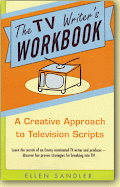



.png)



